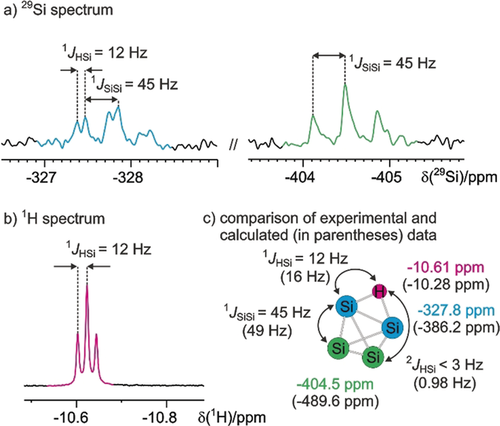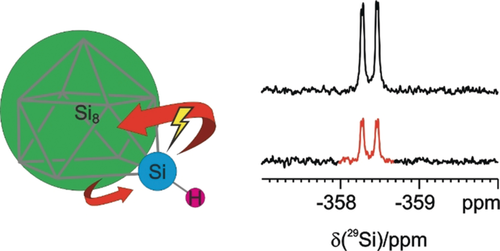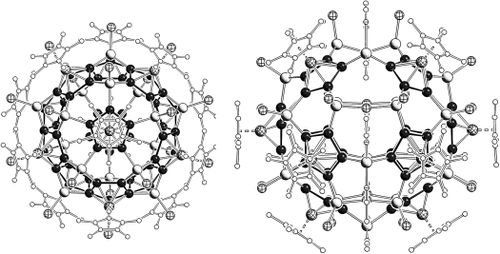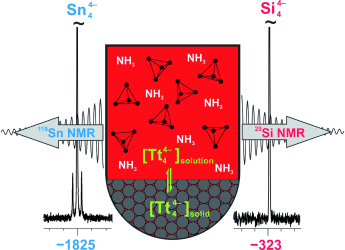 UR Home
UR Home
![]()
Elusive Zintl Ions [µ HSi4]3− and [Si5]2− in Liquid Ammonia: Protonation States, Sites, and Bonding Situation by NMR and Theory
F. Hastreiter, C. Lorenz, J. Hioe, S. Gärtner, L. Nanjundappa, N. Korber, R.M. Gschwind, Angew. Chem. Int. Ed., 2019, 58, 3133-3137.
The existence of [μ-HSi4]3− in liquid ammonia solutions is confirmed by 1H and 29Si-NMR experiments. Both NMR and quantum chemical calculations reveal that the H atom bridges two Si atoms of the [Si4]4− cluster, contrary to the expectation that it is located at one vertex Si of the tetrahedron. The calculations also indicate that in the formation of [μ-HSi4]3−, protonation is driven by a high charge density and an increase of electron delocalization compared to [Si4]4−. Additionally, [Si5]2− was detected for the first time and characterized by NMR. Calculations show that it is resistant to protonation, owing to a strong charge delocalization, which is significantly reduced upon protonation. Thus, our methods reveal three silicides in liquid ammonia: unprotonated [Si5]2−, terminally protonated [HSi9]3−, and bridge?protonated [μ-HSi4]3−. The protonation trend can be roughly predicted by the difference in charge delocalization between the parent compound and the product, which can be finely tuned by the presence of counter ions in solution.

__________________________________________________________________________________________________
[Co@Sn6 Sb6 ]3− : An Off-Center Endohedral 12-Vertex Cluster
R.J. Wilson, F. Hastreiter, K. Reiter, P. Büschelberger, R. Wolf, R.M. Gschwind, F. Weigend, S. Dehnen, Angew. Chem. Int. Ed., 2018, 57, 15359-15363.
We report on the asymmetric occupation of a 12-vertex cluster centered by a single metal atom. Three salts of related intermetalloid cluster anions, [Co@Sn6Sb6]3− (1), [Co2@Sn5Sb7]3− (2), and [Ni2@Sn7Sb5]3− (3) were synthesized, which have pseudo?C4v-symmetric or pseudo-D4h-symmetric 12-vertex Sn/Sb shells and interstitial Co− ions or Ni atoms. Anion 1 is a very unusual single?metal?“centered” 12?atom cluster, with the inner atom being clearly offset from the cluster center for energetic reasons. Quantum chemistry served to assign atom types to the atomic positions and relative stabilities of this cluster type. The studies indicate that the structures are strictly controlled by the total valence electron count—which is particularly variable in ternary intermetalloid cluster anions. Preliminary 119Sn NMR studies in solution, supported by quantum?chemical calculations of the shifts, illustrate the complexity regarding Sn:Sb distributions of such ternary systems.

__________________________________________________________________________________________________
The Structure of [HSi9]3− in the Solid State and Its Unexpected Highly Dynamic Behavior in Solution
C. Lorenz, F. Hastreiter, J. Hioe, L. Nanjundappa, S. Gärtner, N. Korber, R.M. Gschwind, Angew. Chem. Int. Ed., 2018, 57, 12956-12960.
We report on the first unambiguous detection of the elusive [HSi9]3− anion in solutions of liquid ammonia by various 29Si and 1H?NMR experiments including chemical exchange saturation transfer (CEST). The characteristic multiplicity patterns of both the 29Si and 1H resonances together with CEST and a partially reduced 1H,29Si coupling constant indicate the presence of a highly dynamic Si8 entity and a Si−H moiety with slow proton hopping. Theoretical calculations corroborate both reorganization of Si8 on the picosecond timescale via low vibrational modes and proton hopping. In addition, in a single-crystal X-ray study of (K(DB[18]crown-6))(K([2.2.2]crypt))2[HSi9]⋅8.5 NH3, the H?atom was unequivocally localized at one vertex of the basal square of the monocapped square antiprismatic cluster. Thus experimental studies and theoretical considerations provide unprecedented insight into both the structure and the dynamic behavior of these cluster anions, which hitherto had been considered to be rigid.

__________________________________________________________________________________________________
Stability and Conversion of Tin Zintl Anions in Liquid Ammonia Investigated by NMR Spectroscopy
__________________________________________________________________________________________________
A Nano-sized Supramolecule Beyond the Fullerene Topology
The reaction of [CpBnFe(η5?P5)] (1) (CpBn=η5?C5(CH2Ph)5) with CuI selectively yields a novel spherical supramolecule (CH2Cl2)3.4@[(CpBnFeP5)12{CuI}54(MeCN)1.46] (2) showing a linkage of the scaffold atoms which is beyond the Fullerene topology. Its extended CuI framework reveals an outer diameter of 3.7-nm—a size that has not been reached before using five-fold symmetric building blocks. Furthermore, 2 shows a remarkable solubility in CH2Cl2, and NMR spectroscopy reveals that the scaffold of the supramolecule remains intact in solution. In addition, a novel 2D polymer [{CpBnFe(η5?P5)}2{Cu6(μ?I)2(μ3?I)4}]n (3) with an uncommon structural motif was isolated. Its formation can be avoided by using a large excess of CuI in the reaction with 1.

__________________________________________________________________________________________________
Stabilization of Tetrahedral P4 and As4 Molecules as Guests in Polymeric and Spherical Environments
__________________________________________________________________________________________________
Detection of the Elusive Highly Charged Zintl Ions Si44− and Sn44− in Liquid Ammonia by NMR Spectroscopy
The existence of the prototypical Zintl ions Tt44− (Tt=Group-14 element), which are isoelectronic to the P4 molecule, used to be confined to the solid state. Recently, circumstantial evidence for a solution chemistry in liquid ammonia emerged. Direct spectroscopic observation of the dissolved anions has now been achieved. In the case of Si44−, this is the first solution detection of any homoatomic silicide.

Phone: 0941 943-4626
Fax: 0941 943-4617
Room: CH23.1.80
E-Mail





